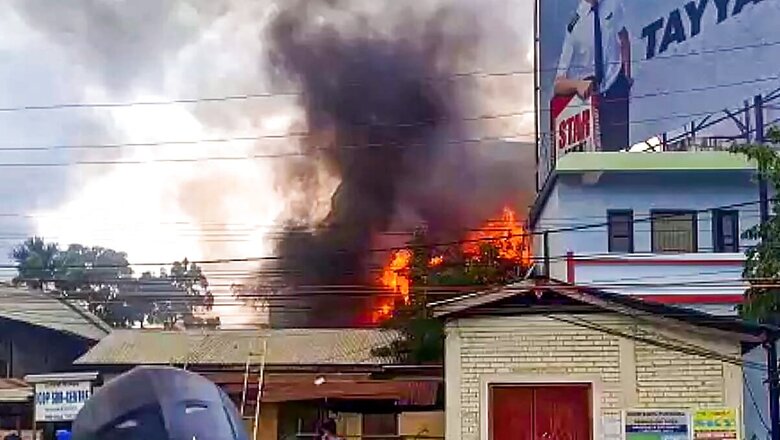
views
Manipur is limping back to normalcy after violence had recently hit the Northeastern state on the issue of granting tribal status to the Meitei community in the state. While the immediate trigger point for this violence was a Manipur High Court judgement in favour of the Meitei community, there are much deeper fault lines that need to be addressed to ensure permanent peace in the state.
Demographic Change In The State
Manipur has witnessed an unnatural growth in the number of villages in certain parts of the state. Many of these habitats have come up on government land that has been illegally encroached on. The present government has been trying to remove these encroachments which have been a cause of friction between the authorities and certain sections of the Kuki community that has dominant numbers in these villages. The majority of the Meitei community lives in and around the state capital Imphal whereas Kuki and Nagas dominate the villages and habitats in the hills surrounding Imphal. Manipur shares a border with Myanmar and it has been reported that there has been significant illegal immigration of Kukis from across the border in the state. It also needs to be mentioned that Kukis are primarily Christians whereas the Meitei community is largely Hindu Vaishnavite.
As per the Gazette status in 1969, the number of villages in the Imphal division, where the Meitei community primarily resides, stood at 587. In 2021, the number came down to 544. In Churachandpur, where the violence started after Kukis held a demonstration, the number of villages increased from 216 in 1969 to 544 in 2021. Overall, the number of villages in Manipur increased from 1957 in 1969 to 2788 in 2021. A major chunk of this increase has been in areas where non-Meiteis reside. This is bound to enhance a sense of insecurity among Meiteis as many of them feel they are getting marginalised in their own home state.
Cannabis and Poppy Cultivation
One of the key factors that has been the least discussed in the state of Manipur is the crackdown of the present government on poppy and cannabis cultivation. These are done illegally in the hills and especially close to the border areas. The severe crackdown by the BJP-led government in the state over the last five years had ruffled many feathers and those affected were looking to settle score with authorities and those who backed the present government. From 2013 to 2016, poppy cultivation was destroyed by the authorities on 1889.3 acres of land. During these four years, cannabis cultivation was destroyed on 66 acres of land. From 2017 to 2023, the government upped its ante and poppy cultivation was destroyed on 18668.3 acres of land. Out of this, around 2700 acres of land under illegal poppy cultivation was in Churachandpur.
Criteria for ST status
Meanwhile, there is a larger issue of criteria for including new communities in the list of Scheduled Tribes. Akhil Bharatiya Vanvasi Kalyan Ashram, the largest voluntary organisation that has been working in the tribal areas for almost seven decades now, passed a resolution in its executive meeting in February 2023 at Ujjain (Madhya Pradesh) that brought to the fore the concerns of the tribal communities of India.
According to this resolution titled, the criteria and procedure laid down by law should be strictly followed in the inclusion of new castes in the list of Scheduled Tribes (STs). Article 366 (25) of the Constitution defines Scheduled Tribes. Certain tribes or groups within such tribes or tribal communities shall be deemed to be “Scheduled Tribes” under Article 342 of the Constitution for the purposes of this Constitution.
Article 342(1) lays down the procedure for this work
The President may, in respect to any State or Union territory, and where it is a State, after consultation with the Governor of that State, by a public notification specify tribes or tribal communities or groups thereof as Scheduled Tribes in relation to that State or UT.
The President recognised the list of Scheduled Tribes in different States of the country, the first time by Constitution (Scheduled Tribes) Order, 1950.
Procedure for inclusion in STs list after 1950
This procedure commences with the recommendation of the concerning State Government for inclusion of any community in the Schedule (List) of the Tribe for the State to the Ministry of Tribal Affairs, after due examination, the Ministry forwards it to the Registrar General of India (RGI) and the National Commission for Scheduled Tribes (NCST) for their consent. Only after the consent of these two authorities, these proposals are sent to the Cabinet, which put these proposals in both the Houses of Parliament. According to Article 342 (2) of the Constitution, the Parliament takes the final decision on all such proposals after 1950.
For inclusion of any new community as a Scheduled Tribe, the RGI and the NCST must follow the criteria laid down by the Lokur Committee, 1965. These prescribed criteria are: signs of primitive traits, distinct culture, geographical isolation, reluctance to contact with wider-other communities and backwardness.
According to ABVKA resolution, “Despite having all such provisions, it is noticed that after 1970, due to immediate political gains and under the pressure of dominant communities, many developed, prosperous and like castes were included in the list of Scheduled Tribes ignoring the prescribed criteria and procedures. The castes which were rejected many times by the Registrar General and Tribal Commission of India for inclusion in the list of Scheduled Tribes or gave negative opinion, Tribal Research Institutes (TRIs) of the states also refused to add them in the Scheduled of STs based on the criteria of Lokur Committee, how suddenly after 75 years it is added to the list of tribes considering it as socio-economically backwards? How government, constitutional and other bodies like RGI, NCST and TRI, change their reports is beyond understanding. And without fulfilling all such criteria and even before the process is completed as per the rules, a political announcement is made to include them in the Scheduled Tribes.”
It further added, “No caste or group should be included in the list of Scheduled Tribes only because of having specific customs or different dialect, but it is necessary to fulfil all the above five criteria of Lokur Committee. Otherwise, the purpose for which Scheduled Tribes have been made separate from Scheduled Castes, Nomadic Tribes, and Other Backward Castes, in the Constitution of India, will have no meaning.”
Expressing concern over the growing clamour for inclusion in the ST list, the ABVKA resolution pointed out, “Owing to this reason, many other castes are competing to include themselves in the list of Scheduled Tribes today. In such a situation, the reservation of jobs and admission for higher education for the real-true Scheduled Tribes, living in geographical isolation and who are economically backward and are backwardness is not only affected, but also their lands are being grabbed by influential dummy tribes. Dominant castes are buying by coming in the list of Scheduled Tribes. As a result, an atmosphere of discontent, unrest and anger is being created in many tribal areas of the country. We can observe such examples in many States.”
Another related issue arises; when new castes were included in the list of Scheduled Tribes after 1950; the population of STs increased due to such inclusion, accordingly the reservation provided to STs at the Centre and different states should also be increased proportionately, but this never happened, the resolution said.
In this context, the executive body of Akhil Bhartiya Vanavasi Kalyan Ashram had urged the Central government to take care of all the above aspects in the inclusion of new castes in the list of Scheduled Tribes. It also called upon the Janjati (tribal) society, especially its socio-political leaders, elected public representatives and the youths to create public awareness in the society to impress upon the governments by all available constitutional means. ‘In doing so, not only their constitutional rights will be protected and anger and unrest in the tribal area will be removed, but this is necessary for the development of any country.’
The writer, an author and columnist has written several books. He tweets @ArunAnandLive. The views expressed in this article are those of the author and do not represent the stand of this publication.




















Comments
0 comment